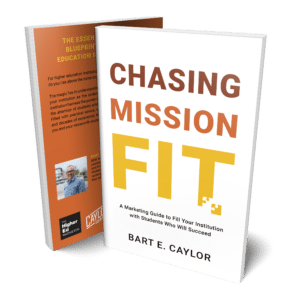How Small Colleges Can Stand Out: Why Your Mission Is More Important than Ever
Learn how small colleges can stand out by using mission-fit marketing to attract the right students and increase enrollment effectively.
Marketing Strategies
One of the most overlooked elements of successful strategic planning in higher education is the critical role of higher ed marketing leaders.
Far too often, marketing is viewed as an afterthought—brought in only to execute promotional tasks after key decisions have already been made.
This disconnect between marketing and institutional strategy can have serious consequences.
Poorly aligned initiatives, misallocated resources, and missed opportunities to engage key audiences are just a few things I’ve seen happen due to this misunderstanding of marketing’s role in the strategic process.
When marketers are absent from the strategic table, institutions risk creating plans that are internally focused, unaware of the broader market forces and student perceptions that should drive decision-making.
This internal echo chamber can result in initiatives that fail to resonate with prospective students, alumni, and other stakeholders.
Ultimately this stunts the institution’s ability to grow, innovate, and compete.

In our conversation, Rob’s insights highlight why it’s essential for higher ed marketers to advocate for their place in the strategic planning process.
We’re not just storytellers! Higher ed marketers can be vital contributors to shaping the institution’s future direction.
By failing to include marketing, institutions may develop strategies that sound great on paper but lack the market orientation and competitive insights necessary to achieve real success.
This episode is a must-listen for anyone involved in higher ed marketing and leadership.
It’s full of actionable advice on how marketing professionals can ensure they’re not just participants in strategic discussions, but key drivers of decisions that lead to growth and impact.
Here are some highlights of our conversation with Rob.
According to Rob, too many strategic plans in higher education lack external focus.
“Institutions are great at talking about themselves to themselves,” Rob says, highlighting a common pitfall in strategic planning.
Often, universities develop plans that are inward-facing, primarily informed by internal stakeholders without considering the perceptions of prospective students or external audiences.
Rob’s research, conducted in partnership with Dr. Amy Hoseman, reveals that nearly two-thirds of the strategic plans they analyzed lacked formal market research!
This is a significant oversight, as the most successful plans are grounded in market orientation—understanding the competitive landscape and the needs of external stakeholders.
Institutions are great at talking about themselves to themselves. Strategic plans are developed for the institution, by the institution.
There’s this disconnect between the outward expression of institutional missions to transform lives, to transform society, and then the inward facing process of strategic planning.
As a result of that inwardly looking strategic planning processes, institutions tend to overestimate their own distinctiveness.
They can’t see the institution like an external stakeholder would or a consumer would.
And because they don’t necessarily look or assess externally in most cases, there’s also a tendency to act as if other institutions across their competitive landscape are going to remain static.
[Leaving out higher ed marketing leaders] is a fundamental weakness of higher ed strategic planning.
A key takeaway from Rob’s insights is the importance of having marketing leaders at the table during strategic planning.
Despite the pivotal role marketing plays in shaping institutional strategy, his research shows that only 38% of strategic planning committees included a senior marketing leader.
“Marketing is often seen as the group that makes things look pretty,” Rob says, “but it should be viewed as a strategic function that brings data, insights, and an external perspective to the table.”
Institutions that include marketing leaders in their strategic planning processes are better equipped to make informed decisions about program development, constituent engagement, and brand positioning.
Without marketing’s input, Rob warns that universities risk creating plans that fail to resonate with their intended audiences or reflect the realities of a competitive higher education market.
One of the most valuable insights Rob shares is the distinction between strategy and planning.
Planning tends to be internally focused, whereas strategy requires making difficult, sometimes uncomfortable choices.
Strategic plans should be about focusing on a few key priorities that require change.
The reality is that in higher ed strategic planning, most strategic plans are much more about planning than actual strategy.
Planning tends to look internally on those things an institution can control.
Strategy gets back to these external forces and environment, accounting for your constituents, the competition, the things that you can’t control and things that are changing, too.
If we could boil strategy down to the essential elements, it would be that strategy is about choices.
Your strategic plan should reflect a set of choices.
If everyone agrees with the things that you are doing, you’re either doing too much or you’re being too vague.
A true strategic plan reflects decisions that will guide an institution toward success.
It forces leaders to confront the challenges and trade-offs required to move forward in a competitive landscape.
In our conversation, Rob stressed the importance of marketing in not only shaping strategic decisions but also helping to manage institutional change.
He explains how marketing leaders can provide valuable insights into external forces and audience expectations, which are essential for crafting a strategy that drives long-term success.
Marketers should be champions for [external audiences]. These are those most important audiences, the constituents who are most vital to the institution and its future.
[Marketers are the] strategists who bring data and insights to the table about these key audiences in the external marketplace.
Marketing leaders as fundamental agents in creating engagement with those key external audiences who are the people who matter most to the institution and its future.
In this role, marketing isn’t just about promotion—it’s about ensuring the institution remains relevant and competitive in an ever-changing higher education environment.
Rob Zinkan’s expertise offers a roadmap for institutions looking to elevate their strategic planning processes.
By focusing on market orientation, including marketing leaders at the table, and embracing true strategic thinking, colleges and universities can create plans that don’t just sit on a shelf but drive real, measurable progress.
Especially when it relates to launching new programs or sunsetting programs, a lot of times marketing is not included in those decisions either.
Many times a proposed new program is the brainchild and love of a particular professor, and as a marketer, you recognize there’s no market for this program. It sounds great, it sounds exciting, but no one wants to buy it.
It is our responsibility as higher ed marketing leaders to insert ourselves into these strategic planning meetings.
In these challenging times for enrollment, we must think of ourselves not only as storytellers and artists, but also as leaders.
Listen to our full interview with Rob Zinkan to get even more insights into:
The essential marketing book every higher education institution needs! If you are a higher education marketing professional seeking a fail-safe plan to make your institution stand out, “Chasing Mission Fit” is your guide.

So you can empower your institution with audience-focused marketing strategies, and attract mission-fit students who will flourish in your unique academic environment.
Ready to transform your institution’s marketing approach?
Order now!
Featured image by BGStock72 via Adobe Stock
Subscribe to The Higher Ed Marketer podcast today!